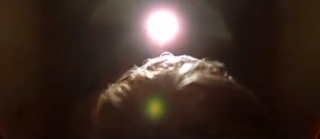This is my analysis of Quentin Tarantino's 'Kill Bill: Volume 2' (2004), looking at the scene of actress Uma Thurman's character being buried alive and the scene of her escape.
Buried alive scene:
Sound is a key element to creating the terror in this scene. There is diegetic sound of crickets, showing isolation and that the scene is taking place in the middle of nowhere, therefore the woman is away from an escape. Along with this, the dark setting outside reveals it's night, therefore no one would be around (again, suggesting the woman's vulnerability in getting away/being saved). This relates to a horror set, suggesting the genre of the film.
The woman looks like she's been beaten up, perhaps she has been held hostage; she is dirty and sweaty with dry blood on her face. The camera shows an eyeline match from the woman at a low angle looking up at a cleaner looking man. This helps to tell us he is in control.
The woman is tied up and forced into an empty wooden box. The camera cuts from inside to outside the box. Placing a camera inside the box may make the audience feel as if they are also trapped in the box, creating a tense atmosphere from the audience. Cross cutting shows a close up of nails being hammered into the wood to nail it shut and the light decreasing inside the box - emphasising the build up to the woman being trapped completely. Non-diegetic sound of high pitched whistling tones are layered with diegetic sound of hammering the nails into the wooden box. In addition, there is also diegetic sound of the woman's heavy breathing. These sounds together are massively exaggerated to create the horror of the situation and build drama.
The more the light dims, the colour of the screen switches to black and white. A continuation of non-diegetic western style music created using mariachi horns is played as she is dropped in the ground. This sad type of music makes the audience feel hopeless towards Uma Thurman's character trapped inside the box. Synchronous sound of gravel thrown onto the box is amplified and enhanced deliberately with the diegetic sound of the woman's heavy breathing, showing her obvious panic. All light dims as the last nail is hammered in, the mariachi music fades into nothing. This quietness shows all hope is gone. The woman is left with a torch which she switches off as we hear diegetic sound of a car driving away. She is alone completely.
Escape scene:
The camera slowly pans from an angle above, looking down on a old grave yard. This immediately sets the scene back to Thurman's character buried underground and makes audience aware something is going to be revealed about her at that current moment. Shown as a wide shot, this reveals the surrounding area; it is night and no one is around. At this moment the audience hear diegetic sound of crickets and insects. This further indicates the atmosphere surrounding the area and how no one is around. The next cut is a medium close up of mud, stating that far beneath this mud is where Thurman's character is trapped. As the screen slowly dims into pitch black, the next light we see comes from inside the box. The camera is placed behind her head and so the torch looks as if it's being switched on at the audience. The camera then tracks the light which is following the edges of the box. This is significant to make the audience believe she is going to try and break free. Non-diegetic western music is played continuously which emits a sense of hardship and success. This leads the audience to believe she is going to be successful in breaking free.
A high angle from behind her looks down at her fiery-red cowgirl boots, indicating her feet take the first step (pun intended) in helping her set herself free inside the box. A low angle looking up from her feet then shows how little space she has and makes the audience feel tense and myself, claustrophobic. Cross cuts at a medium close up from her feet to her face builds tension as the audience ache with anticipation. Close ups highlight the beads of sweat on her face as well as her relief as she manages to untie her feet. Non-diegetic whistling sounds on top of western non diegetic music adds to the feeling of success.










No comments:
Post a Comment